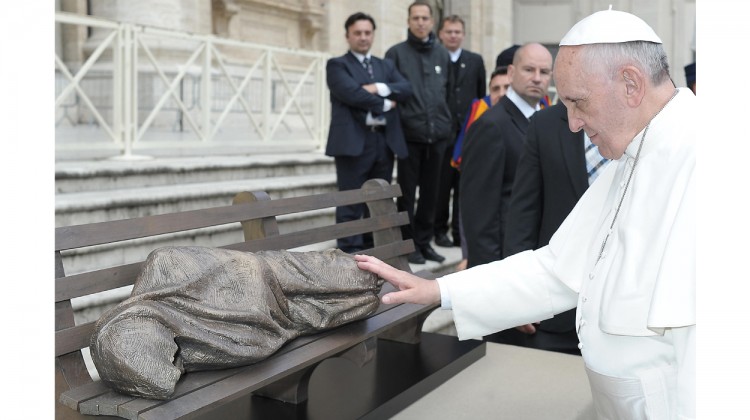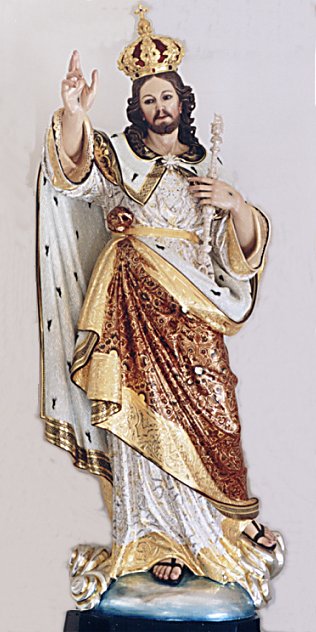
Eine Geschichte von zwei Statuen
Louie 30. Juni 2015

Auf diesem Bild sehen wir, wie Franziskus die Statue
segnet,
die von ihrem Bildhauer "Heimatloser Jesus" genannt wurde.
Es stellt das einzige Bild von Jesus Christus dar, das die Weltlichgesinnten akzeptieren können.
Ein Jesus, der unterdrückt wird und schwach ist; ein Jesus, der von den Missständen der Gesellschaft zum Opfer gemacht wird, nicht anders als so viele andere.
Am wichtigsten ist, dass der "Heimatlose Jesus" schweigt; Er fällt keine Urteile und stellt keine Forderungen über die Bereitstellung eines Bildes, das ein erdgebundenes Schuldgefühl innerhalb der "Besitzenden" provoziert, während es gleichzeitig die Flammen des Klassenkampfes in den "Habenichtsen" schürt.
Das ist der Jesus unseres aktuellen Papstes; der Jesus, nach dem er die Kirche umzubauen beabsichtigt.
Es ist derselbe Jesus, der von Kardinal Oscar Rodríguez Maradiaga beschrieben wird, von dem Mann, den Franziskus persönlich ausgewählt hat, um die Gruppe von Kardinälen zu führen, die ihn über die Neuorganisation der Kurie beraten, der sagte:
Die Funktion der Hierarchie wird neu definiert in Bezugnahme auf Jesus als Gottesknecht, nicht als "Pantokrator" — als Herrn und Herrscher dieser Welt; nur aus der Perspektive von jemandem, der von den Mächten dieser Welt gekreuzigt wurde, ist es möglich, die Autorität der Kirche zu finden und zu erklären.

Dieses Bild hingegen zeigt eine Statue von Christus, dem König.
Es stellt ein Bild von Jesus Christus dar, das die Weltlichgesinnten schwerlich akzeptieren können:
Ein Jesus, der den Tod besiegt hat und auferstanden ist zur Majestät; ein Jesus, der siegreich über die gesamte Gesellschaft herrscht; ein Jesus, der königliche Autorität besitzt über einzelne Menschen, über Familien und über Staaten, seien sie katholisch oder nicht.
Am wichtigsten und zumindest für die Menschen dieser Welt akzeptierbar ist die herrliche Realität, dass Christus, der König, auch heute noch durch die heilige katholische Kirche spricht; dieselbe ist von Ihm gegründet worden, sie ist mit der Fülle der göttlichen Offenbarung ausgestattet worden und ihr wurde das Recht gewährt, über persönliche und soziale Verpflichtungen der Menschheit zu urteilen.
Die Unzulänglichkeit der Darstellung des "Heimatlosen Jesus" liegt in der Tatsache, dass sie im besten Fall eine Halbwahrheit ist.
Unser Herr sagte uns:
Alsdann wird der König zu denen auf seiner Rechten sagen: Kommet, ihr Gesegneten meines Vaters, nehmt Besitz von dem Reich, das euch seit Grundlegung der Welt bereitet ist! Denn ich war hungrig, und ihr habt mich gespeist; ich war durstig, und ihr habt mich getränkt; ich war ein Fremdling, und ihr habt mich beherbergt; (ich war) nackt, und ihr habt mich bekleidet; ich war krank, und ihr habt mich besucht; ich war im Gefängnis, und ihr seid zu mir gekommen. Dann werden ihm die Gerechten entgegnen: Herr, wann haben wir dich hungrig gesehen und dich gespeist, oder durstig und dich getränkt? Wann haben wir dich als Fremdling gesehen und dich beherbergt, oder nackt und dich bekleidet? Oder wann haben wir dich krank oder im Gefängnis gesehen und sind zu dir gekommen? Der König wird ihnen antworten: Wahrlich, ich sage euch: Was ihr einem von diesen meinen geringsten Brüdern getan habt, das habt ihr mir getan! Matthäus 25: 34-40)
Damit wir wirklich diese herrliche Einladung, Unserem Herrn in der Person unseres Nachbarn zu dienen, gerne annehmen, ist es erforderlich, dass wir Jesus Christus so sehen, wie er wirklich ist.
In der oben angeführten Schriftstelle — dieselbe, die allzu oft von denen in der Kirche missinterpretiert wird, die sich fast ausschließlich auf Fragen konzentrieren, die mit zeitlicher Armut und sozialer Gerechtigkeit zusammenhängen, — beachtet gut, wer es ist, der sagt: "Was ihr einem Meiner geringsten Brüder getan habt, das habt ihr mir getan."
Es ist der König!
Diese Lektion sollte deutlich sein:
Eine Sache ist es, Jesus Christus im Gesicht des Obdachlosen zu sehen; etwas ganz anderes ist es, die Schwachen und Unterdrückten in Christus, dem König, zu sehen.
Das Erstere ist eine Gelegenheit der Gnade, Letzteres ein großes Unrecht, das an christologische Häresie grenzt.
Wählt eure Christusbilder sehr sorgfältig aus, meine Freunde.
https://harvestingthefruit.com/a-tale-of-two-statues/https://harvestingthefruit.com/a-tale-of-two-statues/
A tale of two statues
Louie June 30, 2015 27 Comments
Above, we see Pope Francis blessing the statue named by its sculptor, “Homeless Jesus.”
It represents the only image of Jesus Christ that the worldly can accept:
A Jesus who is downtrodden and weak; a Jesus victimized by society’s ills, not unlike so many others.
Most importantly, the “Homeless Jesus” is silent; He no judgments and makes no demands beyond providing an image that provokes an earthbound sense of guilt within the “haves,” while simultaneously fanning the flames of class warfare within the “have nots.”
This is the Jesus of our current pope; the one after which he intends to remodel the Church.
It is the same Jesus described by Cardinal Oscar Rodríguez Maradiaga, the man Pope Francis personally chose to lead the group of cardinals advising him on the Curia’s reorganization, who said:
The function of the hierarchy is redefined in reference to Jesus as Suffering Servant, not as “Pantocrator” – lord and emperor of this world; only from the perspective of someone crucified by the powers of this world it is possible to found, and to explain, the authority of the Church.
On the right, by contrast, is a statue of Christ the King.
It represents an image of Jesus Christ that the worldly find difficult to accept:
A Jesus who defeated death and is Risen unto Majesty; a Jesus who reigns victorious over all of society; a Jesus who possesses Kingly authority over individuals, families, and States, be they Catholic or otherwise.
Most importantly, and least acceptable to the men of this world, is the glorious reality that Christ the King speaks even today through the Holy Catholic Church; the same established by Him, endowed with the fullness of Divine Revelation, and granted the right to pass judgment on the personal and social obligations of humankind.
The deficiency of the “Homeless Jesus” image lies in the fact that it is, at best, a half-truth.
Our Blessed Lord told us:
Then the King will say to those at his right hand, ‘Come, O blessed of my Father, inherit the kingdom prepared for you from the foundation of the world; for I was hungry and you gave me food, I was thirsty and you gave me drink, I was a stranger and you welcomed me, I was naked and you clothed me, I was sick and you visited me, I was in prison and you came to me.’
Then the righteous will answer him, ‘Lord, when did we see thee hungry and feed thee, or thirsty and give thee drink? And when did we see thee a stranger and welcome thee, or naked and clothe thee? And when did we see thee sick or in prison and visit thee?’ And the King will answer them, ‘Truly, I say to you, as you did it to one of the least of these my brethren, you did it to me.’ (Matthew 25:34-40)
In order for us to truly embrace this magnificent invitation to minister unto Our Lord in the person of our neighbor, it is necessary for us to see Jesus Christ as He truly is.
In the Scripture passage above – the same that is all-too-often misappropriated by those in the Church who focus almost exclusively on matters related to temporal poverty and social justice – note very well who it is that says, “as you did it to one of the least of these my brethren, you did it to me.”
It is the King!
The lesson should be clear:
It’s one thing to see Jesus Christ in the face of the homeless; it is quite another to see the weak and the downtrodden in Christ the King.
The former is an of grace; the latter, a grave injustice that borders on Christological heresy.
Choose your images of Christ very carefully, my friends.
https://harvestingthefruit.com/a-tale-of-two-statues/https://harvestingthefruit.com/a-tale-of-two-statues/